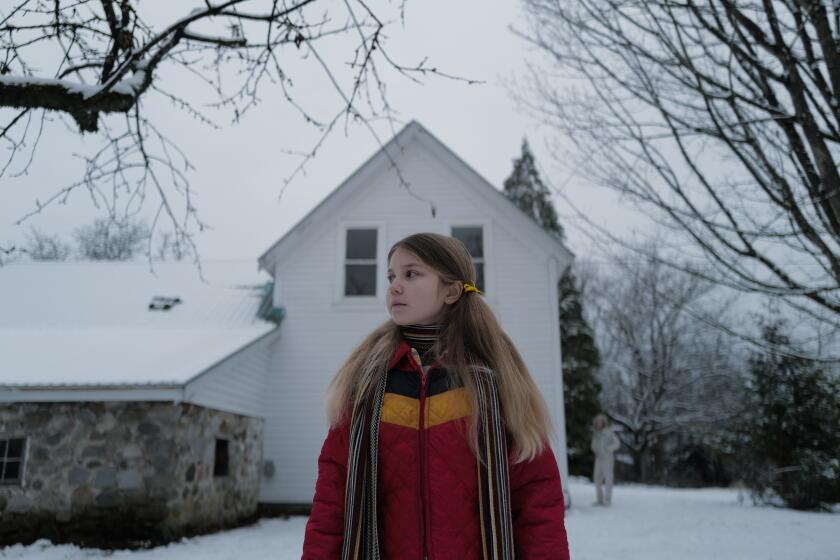Book review: ‘The Story of “Charlotte’s Web”’
With the publication of “Charlotte’s Web” in the fall of 1952, a guileless pig named Wilbur and the savvy spider who befriended him were introduced to readers. In a review, Eudora Welty praised E.B. White’s novel for its “felicity, tenderness and unexpectedness, grace and humor and praise of life, and the good backbone of succinctness that only the most highly imaginative stories seem to grow.”
Five decades later, in “The Story of ‘Charlotte’s Web,’” Michael Sims offers a full, engaging account of this classic. (Sims has also written “Adam’s Navel: A Natural and Cultural History of the Human Form” and edited “The Annotated Archy and Mehitabel,” among other books.)
White was a shy man who “hid behind animals” in one way or another throughout his life, Sims writes. The characters that populate “Charlotte’s Web” were drawn from the barns and stables of his childhood; animals were his closest friends. “This boy felt for animals a kinship he never felt for people,” White once wrote of himself.
Elwyn Brooks White was born in 1899, the youngest of seven children (though one died in infancy), in Mount Vernon, N.Y. On the family’s property was a large stable that housed chickens, rabbits, horses and other creatures, as well as various spiders that captivated the boy’s attention with their elaborate webs. It was here, in this bucolic setting, that he came to understand “animals were actors themselves, living their own busy lives, not merely background characters in his own little drama,” Sims writes. Whenever he read books, he tended to choose stories about animals and the natural world.
Following his undergraduate education at Cornell University, Elwyn — nicknamed Andy, as he would be known for the rest of his life — moved to Manhattan, where in 1925 he submitted some pieces to a new magazine called the New Yorker. A year later, he joined the staff, working with a beautiful editor, Katharine Angell. She had hired him, and she would become his wife (after the collapse of her own marriage) and his most important and devoted reader.
Along with raising Katharine’s children, Nancy and Roger, the couple had a son, Joel, born in 1930. A few years later, they were able to buy a 40-acre farm in Maine, and it was this place — “with the romanticized freedom of farm life calling from behind the urban world’s honking horns and claustrophobic subways” — that would put White on his way to creating “Stuart Little” in 1945 and “Charlotte’s Web” seven years later.
One of the central themes of “Charlotte’s Web,” of course, is mortality, and White contends with death as a harsh truth: A pig is saved from slaughter but must eventually mourn the loss of his best friend. This theme was informed partly by the author’s own ethical struggles as a farmer — one who tended lovingly his own pig or lamb until “he was scheduled to betray the creature’s confidence and slaughter it.”
Although White was well-acquainted with the habits of farm animals, he realized once he began working on “Charlotte’s Web” that he had a good deal to learn about spiders. He had always been captivated by them (rather than fearful), but he lacked some essential scientific knowledge. As Sims notes, White spent several months obsessively researching spiders, understanding their anatomy and precisely how their webs are spun. And because he found out that “[s]piders live short and busy lives,” there could be no question of Charlotte’s demise before the story’s end.
The book’s final third is its most engaging section. As White immerses himself in the writing of his masterpiece, Sims includes wonderful anecdotes, such as how White settled upon Charlotte’s surname (and the other characters’ names), and how closely White collaborated with Garth Williams on the marvelous illustrations. Sims also includes drafts of White’s cross-outs and false starts, revealing the author’s rigorousness at every level.
“I would rather wait a year than publish a bad children’s book,” White once said, “as I have too much respect for children.” That might explain why he set aside “Charlotte’s Web” in a cardboard box for months after completing the first draft. It wasn’t until he returned to it that he added Fern Arable, the little girl who loves Wilbur dearly. Later, at the urging of his legendary editor, Ursula Nordstrom, at Harper & Bros., White changed the penultimate chapter title “Charlotte’s Death” to the less blunt “Last Day.” (Redemption is offered at the end, through Wilbur’s friendships with Charlotte’s children and grandchildren, although as White wrote, “none of the new spiders ever quite took her place in his heart.”)
“The Story of ‘Charlotte’s Web’” unfolds in a way that White might have appreciated: It ambles, pauses to observe the smallest details, and takes its time. Best of all, this book is likely to encourage readers to experience the pleasures of White’s novel all over again. That’s certainly fine, since, as Welty had noted, “Charlotte’s Web” is perfect for readers “over the age of eight or under the age of eighty.”
Ciuraru is the author of “Nom de Plume: A (Secret) History of Pseudonyms.”
More to Read
The biggest entertainment stories
Get our big stories about Hollywood, film, television, music, arts, culture and more right in your inbox as soon as they publish.
You may occasionally receive promotional content from the Los Angeles Times.






